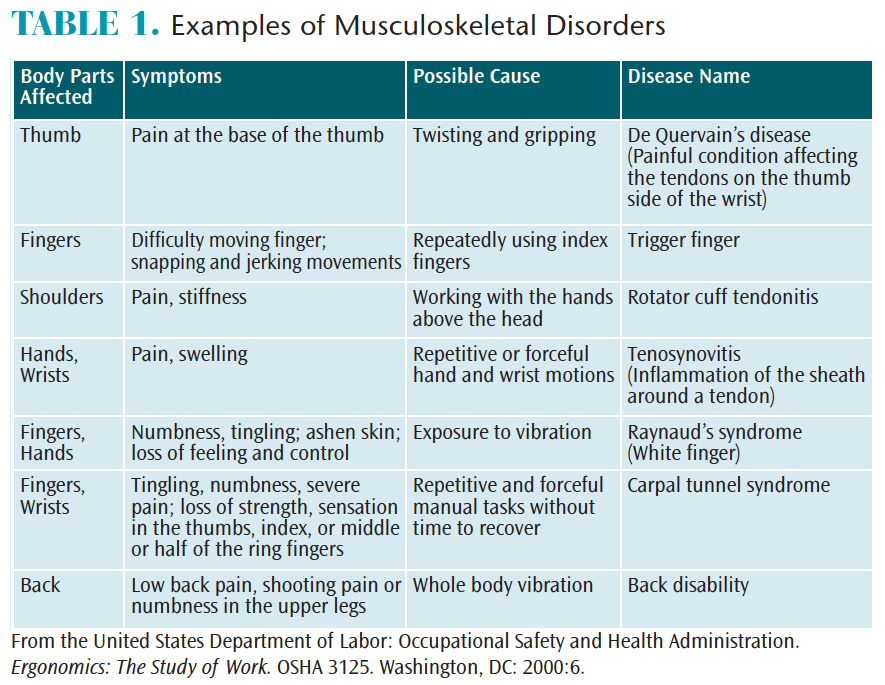
A Profession at Risk
Oral health professionals need to develop a prevention plan to reduce their risk of musculoskeletal disorders.
Oral health professionals—dentists, dental hygienists, dental therapists, and dental assistants—work collaboratively every day to meet the needs of their patients. While providing oral health care can be highly rewarding, dental professionals are also at elevated risk of musculoskeletal disorders. As such, they must be mindful of using proper ergonomics during the workday. Ergonomics is the science of designing the occupation to accommodate the employee, rather than physically coercing the employee to acclimate to the occupation. Oral health professionals must consider modifying tasks, operatories, instruments, and equipment to help reduce physical stress on their bodies and eliminate many potentially serious, disabling work-related musculoskeletal disorders.1–4
Musculoskeletal disorders affect the muscles, nerves, blood vessels, ligaments, and tendons and usually result from exposure to multiple risk factors that can cause or exacerbate the disorders, not from a single event or trauma.1–4 Oral health professionals are particularly vulnerable to risk factors, such as bending, twisting, reaching, treating patients with incorrect operator/patient positioning, and performing the same or similar repetitive procedures in a static posture. Exposure to these factors increases oral health professionals’ risk for injury;1–4 however, proper workplace ergonomics can help to reduce these risks.
OCCUPATIONAL HEALTH HAZARDS
Work-related musculoskeletal disorders are a significant occupational health issue among health care providers.5–8 In a cross-sectional study that included surgeons, physicians, and dentists, the highest prevalence of musculoskeletal pain was reported by dentists at 61%.5 Additionally, 60% of dentists with musculoskeletal disorders had problems in more than one site.5
Another research study demonstrated that the prevalence of general musculoskeletal pain among oral health professionals ranged from 64% to 93%.9 Investigators found that musculoskeletal disorders among dental and dental hygiene students were limited to specific sites. Overall, the results suggested that musculoskeletal problems represent a significant burden for oral health professionals.9 Multisite musculoskeletal disorders in oral health professionals are caused by the need for intricate operator/patient positioning during treatment and long working hours with repetitive movement.
LONG-TERM IMPACT
Work-related musculoskeletal disorders are among the most frequently reported causes of lost or restricted work time in the United States. According to the US Department of Labor Occupational Health and Safety Administration (OSHA), musculoskeletal disorders account for 34% of all worker injury and illness cases.1 Employers report nearly 600,000 musculoskeletal disorders among their employees, requiring time away from work every year. Musculoskeletal disorders account for $1 of every $3 spent on workers’ compensation for a total of more than $15 billion to $20 billion in workers’ compensation costs.1 On average, it takes employees 28 days to recover from carpal tunnel syndrome, while severe injuries can cause permanent disability that prevents them from returning to work or completing simple, everyday tasks.1
The most commonly reported musculoskeletal disorders in the oral health profession are carpal tunnel syndrome, tendonitis, rotator cuff injuries, epicondylitis, trigger finger, muscle strains, and lower back injuries.1 Hayes et al4 reported that dentists experienced pain most often in the back (36.3% to 60.1%) and neck (19.8% to 85%), while the hand and wrist regions were the most prevalent sites for pain among dental hygienists (60% to 69.5%).

Research shows the highest ergonomic risk among oral health professionals is posed by scaling and root planing due to the repetitive motion required.10 The vibration caused by some instruments also contributes to musculoskeletal disorders. The use of ultrasonic scalers and polishing handpieces may cause neck, shoulder, and back pain due to the prolonged sitting required, holding a physical load with flexion of the neck and trunk, and encouragement of poor posture.10 Oral health professionals often maintain static and awkward postures of at least 40 minutes, which is directly related to neck, shoulder and back pain.10 Table 1 displays some commonly reported musculoskeletal disorders among health care professionals.
STARTING WITH STUDENTS
A study that looked at dental hygienists and dental hygiene students who self-reported musculoskeletal disorders compared with those who had physician-diagnosed musculoskeletal disorders found that 37% of self-reported neck symptoms were reported by dental hygiene students and 72% of self-reported neck symptoms were reported by dental hygienists. Among those who had physician-diagnosed neck problems, 22% were found among dental hygiene students and 47% were in dental hygienists.11Remarkably, the rate of dental hygiene students reporting musculoskeletal disorders was quite high, considering they have not begun full-time clinical practice. This research demonstrates the importance of beginning ergonomic education at the student level. Experienced dental hygienists were 2.5 times more likely to have physician findings of neck musculoskeletal disorders compared with the combined dental hygiene student group.11
STRATEGIES FOR RISK REDUCTION
Dental hygienists, dental therapists, and dentists perform precise, repetitive movements of the upper limbs while bending forward and twisting at the waist to view the oral cavity, increasing ergonomic risk. Strategies, such as stretching and neutral body positioning, have been suggested to minimize risk factors associated with musculoskeletal disorders. The use of these tools support longer, healthier clinical careers, increase productivity, provide safer workplaces and reduce the risk of musculoskeletal disorders.12–15
Yoga is a system of physical exercises and/or postures performed in sequence, designed to align the skin, muscles, and bones. The postures are also designed to open the channels and energies of the body, specifically the spine. In addition to stretching during the workday, a study found that yoga is beneficial in reducing musculoskeletal disorders.16 The study concluded that participants who attended two yoga sessions per week reduced musculoskeletal disorders, thereby increasing the health and longevity of a dental hygiene career.16 An additional research study found that yoga not only strengthens the musculoskeletal system but also decreases stress by releasing endorphins and other hormones, which is another contributing factor to musculoskeletal discomfort among oral health professionals.17 Yoga is found to be more effective than other modes of physical activities because of its more controlled nature and its positive effect on psychological stress.17
Oral health professionals should consider other preventive measures, such as postural awareness, using loupes, proper operator/patient positioning, large-diameter instruments, ergonomically friendly gloves that provide a better grip and fit, cordless instruments, and ultrasonic instrumentation where appropriate to ease repetitive stress. Alternating between standing and sitting while treating patients and avoiding stationary positions can also aid in preventing musculoskeletal disorders.18–20
CONCLUSION
Musculoskeletal disorders are multifaceted, and recognizing the risk factors at the earliest stage may help improve treatment outcomes. Musculoskeletal disorders are highly prevalent in oral health professionals, who frequently report musculoskeletal pain in their shoulders and neck, hands and wrists, low back, or forearms and elbows.12 Clinicians must follow proper ergonomic principles to reduce the use of awkward postures and decrease injury risk.
Oral health professionals should consider redesigning their workstations to promote proper operator/patient positioning, examining the impact of instrument use on upper extremity pain, and following healthy work practices to reduce stress.12 Those who are mindful in proper workplace ergonomics and take preventive measures toward musculoskeletal disorders are more likely to sustain and extend their careers in patient care.
REFERENCES
- United States Department of Labor: Occupational Safety and Health Administration. Ergonomics: The Study of Work. Washington, DC; 2000:1–14.
- Al-Hourani Z, Nazzal M, Khader Y, Almhdawi K, Bibars AR. Work-related musculoskeletal disorders among Jordanian dental technicians: Prevalence and associated factors. Work. 2017;56:617–623.
- Occhionero V, Korpinen L, Gobba F. Upper limb musculoskeletal disorders in healthcare personnel. Ergonomics. 2014;57:1166–1191.
- Hayes MJ, Taylor JA, Smith DR. Predictors of work-related musculoskeletal disorders among dental hygienists. Int J Dent Hyg. 2012;10:265–269.
- Rambabu T, Suneeth K. Prevalence of work related musculoskeletal disorders among physicians, surgeons and dentists: a comparative study. Ann Med Health Sci Res. 2014;4:578–582.
- Park JH. Association among work-related musculoskeletal disorders, job stress, and job attitude of occupational therapists. Occup Ther Health Care. 2017;31:34–43.
- Muaidi QI, Shanb AA. Prevalence causes and impact of work related musculoskeletal disorders among physical therapists. J Back Musculoskelet Rehabil. 2016;29:763–769.
- Macdonald W, Oakman J. Requirements for more effective prevention of work-related musculoskeletal disorders. BMC Musculoskelet Disord. 2015;16:293.
- Hayes M, Cockrell D, Smith D. A systematic review of musculoskeletal disorders among dental professionals. Int J Dent Hyg. 2009;7:159–165.
- Chaiklieng S, Suggaravetsiri P. Ergonomics Risk and Neck Shoulder Back Pain Among Dental Professionals. Philadelphia: Elsevier: 2015;4900–4905.
- Morse T, Bruneau H, Michalak-Turcotte C, et al. Musculoskeletal disorders of the neck and shoulder in dental hygienists and dental hygiene students. J Dent Hyg. 2007;81:1–16.
- Nutalapati R, Gaddipati R, Chitta H, Pinninti M, Boyapati R. Ergonomics in Dentistry and the Prevention of Musculoskeletal Disorders in Dentists. Available at: http://ispub.com/IJOH/1/1/6253. Accessed August 22,2017.
- Van Eerd D, Munhall C, Irvin E, et al. Effectiveness of workplace interventions in the prevention of upper extremity musculoskeletal disorders and symptoms: an update of the evidence. Occup Environ Med. 2016;73:62–70.
- Rodrigues EV, Gomes AR, Tanhoffer AI, Leite N. Effects of exercise on pain of musculoskeletal disorders: a systematic review. Acta Ortop Bras. 2014;22:334–348.
- Gartley RM, Prosser JL. Stretching to prevent musculoskeletal injuries. An approach to workplace wellness. AAOHN J. 2011;59:247–252.
- Monson A, Chismark A, Cooper B, Krenik-Matejcek T. Effects of yoga on musculoskeletal pain. J Dent Hyg. 2017;91:15–22.
- Koneru S, Tanikonda R. Role of yoga and physical activity in work-related musculoskeletal disorders among dentists. J Int Soc Prev Community Dent. 2015:5:199–204.
- Sunell S, Rucker L. Surgical magnification in dental hygiene practice. Int J Dent Hyg. 2004;2:26–35.
- Rempel D, Lee D, Dawson K, Loomer P. The effects of periodontal curette handle weight and diameter on arm pain. J Am Dent Assoc. 2012;143:1105–1113.
- Crawford L, Gutierrez G, Harber P. Work environment and occupational health of dental hygienists: A qualitative assessment. J Occup Environ Med. 2005;47:623–632.
Featured photo by TWINSTERPHOTO/ISTOCK/GETTY IMAGES PLUS
From Dimensions of Dental Hygiene. September 2017;15(9):22,25-26,29-30.

